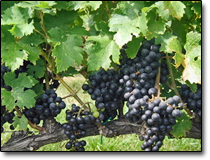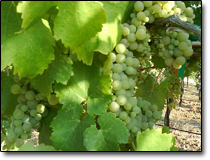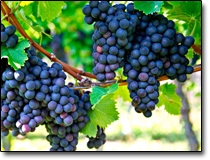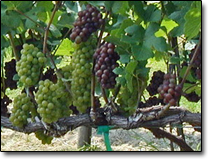 Cabernet Franc
Cabernet Franc
Cabernet Franc was one of the first varietals planted at Toll Gate Farm and is one of the major black grape varieties worldwide. It is principally grown for blending with Cabernet Sauvignon and Merlot in the Bordeaux style, but can also be vinified alone - as in the Loire's Chinon. In addition to being used in blends it is also produced as a varietal.
Lighter than Cabernet Sauvignon, Cabernet Franc makes a bright pale red wine on its own. It also contributes finesse and a peppery perfume to blends with more robust grapes. Depending on growing region and style of wine, additional aromas can include tobacco, raspberry, and cassis, sometimes even violets.
Records of Cabernet Franc in Bordeaux go back to the end of the 18th century; it was planted in Loire long before that. DNA analysis indicates Cabernet Franc is one of two parents of Cabernet Sauvignon, a cross between it and Sauvignon Blanc.
 Viognier
Viognier
Viognier is a temperamental grape that can break your heart or make you swoon. The wine is luscious with flavor and tropical fruit undertones. But the grape itself can be difficult to grow, often has low and unpredictable yields, and should be picked only when fully ripe. Bill and Patty planted an acre of Viognier in 2002 and more a few years later.
Winemakers in the Condrieu region of France often pick the grapes with a level of sugar that will produce wine with alcohol in the 13% range. When fully ripe the grapes have a deep yellow color and produce wine with a strong perfume and high in alcohol. The grape prefers warmer environments and a long growing season, but can grow in cooler areas as well.
The origin of the Viognier grape is unknown. Viognier is presumed to be an ancient grape, and some have hypothesized that it may have originated in Dalmatia and was brought to Rhône by the Romans. One legend states that the Roman emperor Probus brought the vine to the region in 281 AD. Another legend has the grape packaged with Syrah on a cargo ship navigating the Rhone River en route to Beaujolais when it was captured near the site of present day Condrieu by a local group of outlaws known as culs de piaux.
The origin of the name Viognier is also obscure. The most common namesake is the French city of Vienne, which was a major Roman outpost. Another legend has it drawing its name from the Roman pronunciation of the via Gehennae, meaning the "Valley of Hell". Probably this is an allusion to the difficulty of growing the grape.
 Petit Verdot
Petit Verdot
Petit Verdot is a variety of red wine grape, principally used in classic Bordeaux blends. It was the last varietal planted at Toll Gate Farm. Petit Verdot ripens much later than the other varieties in Bordeaux, often too late, so it fell out of favor in its home region. When it does ripen, it is added in small amounts to add tannin, color and flavor to the blend. It has attracted attention among winemakers in the New World, where it ripens more reliably and has been made into single varietal wine. It is also useful in 'stiffening' the mid palate of Cabernet Sauvignon blends.
When young, its aromas have been likened to banana and pencil shavings. Strong tones of violet and leather develop as it matures. Petit Verdot probably predates Cabernet Sauvignon in Bordeaux, but its origins are unclear. There are records of it in the eighteenth century, but its characteristics suggest an origin in much hotter climes than the Gironde.
It is one parent of Tressot, the other parent being Duras, a grape from the upper Tarn valley near Toulouse. It's possible that both were brought to the region by the Romans as they moved inland from the Mediterranean.
 Pinot Grigio
Pinot Grigio
Pinot Grigio (Pinot Gris) is a white wine grape variety of the species Vitis Vinifera. Wine made from Toll Gate Farm’s Pinot Grigio consistently wins awards for the wineries that buy the grapes and quickly sells out. Thought to be a mutant clone of the Pinot Noir grape, it normally has a grayish-blue fruit, accounting for its name (gris meaning "grey" in French) but the grape can have a brownish pink to black and even white appearance. The word pinot, which comes from the word meaning "pine cone" in French, could have been given to it because the grapes grow in small pine cone-shaped clusters. The wines produced from this grape also vary in color from a deep golden yellow to copper and even a light shade of pink, and it is one of the more popular grapes for orange wine.
Pinot gris has been known from the Middle Ages in the Burgundy region, where it was probably called Fromenteau. It spread from Burgundy, along with Pinot noir, arriving in Switzerland by 1300. The grape was reportedly a favorite of the Emperor Charles IV, who had cuttings imported to Hungary by Cistercian monks: the brothers planted the vines on the slopes of Badacsony bordering Lake Balaton in 1375. The vine soon after developed the name Szürkebarát meaning "grey monk." In 1711, a German merchant, named Johann Seger Ruland (re)discovered a grape growing wild in the fields of the Palatinate. The subsequent wine he produced became known as Ruländer and the vine was later discovered to be Pinot Gris.
Until the 18th and 19th century, the grape was a popular planting in Burgundy and Champagne but poor yields and unreliable crops caused the grape to fall out of favor in those areas. The same fate nearly occurred in Germany, but vine breeders in the early 20th century were able to develop clonal varieties that would produce a more consistent and reliable crop.
Researchers at the University of California, Davis, have determined that Pinot Gris has a remarkably similar DNA profile to Pinot Noir and that the color difference is derived from a genetic mutation that occurred centuries ago. The leaves and the vines of both grapes are so similar that the coloration difference is the only thing that tells them apart.
Supporting this conclusion, in our vineyard we have have Pinot Grigio vines where some shoots have white variations as well as black variations alongside their copper/purple brethren all on the same vine. A truly interesting phenomenon.